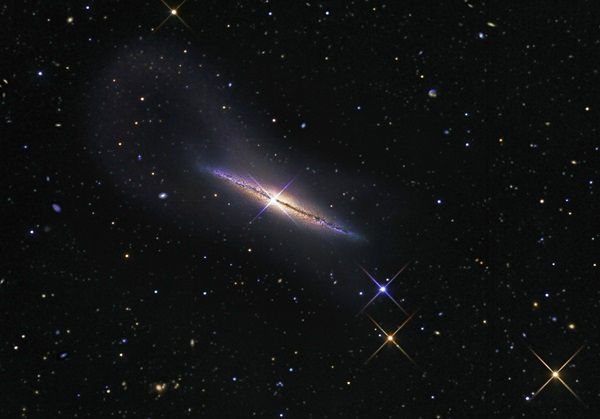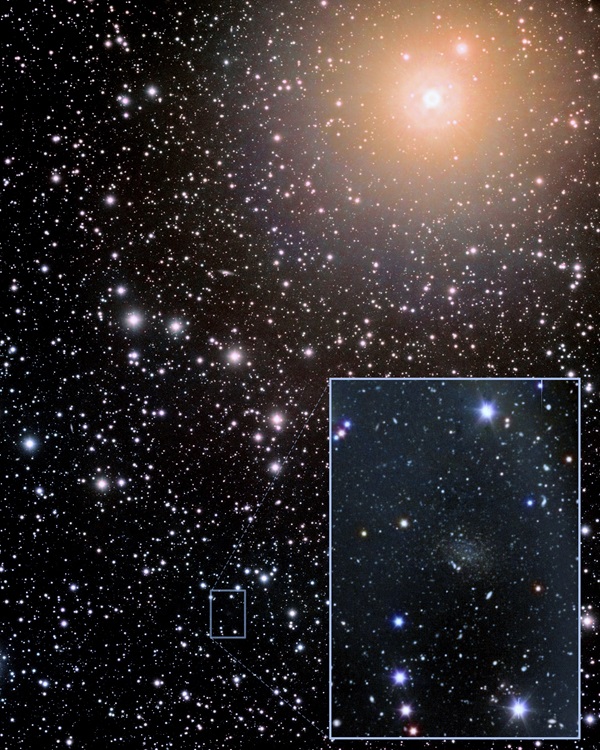Key Takeaways:
From the time Galileo first peered into his telescope until the middle of the 19th century, professional telescopes required the observer to look through an eyepiece. As a result, astronomers manually logged mountains of information and telescopic drawings in journals.
Then came photography. Almost from its inception, photography offered the tantalizing prospect of serving as a tool to discover and document new, hitherto-unseen phenomena. In fact, by the beginning of the 20th century, advancements in photography enabled career astronomers to lay down their pencils and trade their telescope eyepieces for glass plates coated with photographic emulsions.
In addition to appealing to professional astronomers, this potential captured the imagination of resourceful amateur astronomers equipped with modest instruments as well. One such amateur was sanitary engineer Andrew Common. In 1883, he took the first photograph of faint structures in the Orion Nebula (M42) that were not visible through an eyepiece. Others, photographing a plethora of objects, quickly followed.
Paving the way
As the 21st century dawned, the digital imaging technology that had already replaced chemical photography at professional observatories began to trickle down into consumer products. This enabled amateur astronomers to purchase, at a reasonable cost, computer-controlled charge-coupled device (CCD) cameras expressly designed for use with small telescopes. At the same time, motorized mounts driven by electronic maps of the sky enabled amateurs to place any celestial object at the center of an electronic imaging chip and track it with high precision.
As a result, modest equipment became a tool for obtaining ultra-deep images that could capture the outskirts of nearby massive galaxies and survey vast areas of the sky with unprecedented depth. This enabled a new type of collaboration between world-class amateur astroimagers and international teams of professional astronomers exploring one of the fundamental questions in modern astrophysics: How did massive galaxies like our Milky Way come to be?
The standard model of the universe’s formation predicts that the elegant galactic spirals we see today, including our own Milky Way, arose hierarchically. They did this by capturing much smaller galaxies, some only composed of dark matter. State-of-the-art computer models indicate the Local Group and its neighbors should still contain evidence of this ancient galactic cannibalism.
During the last decade, amateur telescopes have revealed, in many cases for the first time, an assortment of large-scale tidal structures around nearby massive galaxies. They also have imaged formerly unknown nearby low-surface-brightness star systems. And amateurs using telephoto lenses have traced interactions between the Magellanic Clouds and other Milky Way satellite galaxies. All of these amazing images have provided evidence to support our understanding of galactic evolution as predicted by current simulations.
Amateurs at work
Ultra-deep observations of nearby spiral galaxies and regions around them have been obtained by world-class American, European, and Chilean amateur astroimagers. They operate privately owned observatories that use high-quality apochromatic and Ritchey-Chrétien telescopes with apertures between 4 and 32 inches (0.1 and 0.8 meter). Each observing location features spectacularly dark, clear skies with typical seeing less than 1.5″.
These modest telescopes — and, in some cases, telephoto lenses — are coupled with off-the-shelf CCD cameras equipped with the latest generation of imaging chips. They can probe vast sky areas with unprecedented depth — approximately three magnitudes fainter than either classic photographic plate surveys like the Palomar Observatory Sky Survey or more recent digital surveys like the Sloan Digital Sky Survey (SDSS).
Camera sensitivity, fast operation, and lack of the competition for observing time typical of professional observatories places these low-cost robotic amateur facilities at the front line of ultra-deep imaging. They allow high-impact research of structures in nearby low-surface-brightness galaxies. Doing so requires multiple seven- and eight-hour exposures of each galactic target using high-throughput luminance (clear) filters for visible-light imaging. To capture fuzzy emission line structures in galactic halos, imagers use narrowband Hydrogen-alpha filters.
These observations demonstrate in several ways the feasibility of smaller telescopes to detect very faint diffuse structures in large fields around nearby galaxies. First, small short-focal-length telescopes combined with single-chip cameras cover a larger field of view. Second, the use of single-chip detectors also makes it easier to flatten the external regions around galaxies in comparison to standard multi-chip detector arrays used with professional telescopes. Finally, observations with large telescopes are sometimes subject to glare from nearby bright stars and significant sky background variations from different sources. These artifacts complicate or mask the detection of faint structures, and their correction adds significant observing time overhead to the data-gathering process.
Searching for stellar streams
Computer simulations predict that the stellar halos of massive galaxies contain an assortment of tidal debris streams that long exposures should reveal. The most spectacular examples are those that wrap around the host galaxy and roughly trace the orbit of the progenitor satellite galaxy that created them.
These streams cannot be resolved into individual stars and thus appear as elongated, diffuse light features with an angular extent of several arcminutes. Detecting them requires long-exposure, wide-field images encompassing the outskirts of the host galaxies. Working with amateur astroimagers over the last decade, we have imaged nearby spiral galaxies as part of the Stellar Tidal Stream Survey.
This observational effort has discovered almost 50 previously undetected tidal streams around our targets. The extraordinary variety of faint structures is compelling evidence that supports the hierarchical nature of galaxy formation predicted by the standard cosmological model.
In addition to circular features similar to the Sagittarius stream surrounding the Milky Way, our data have revealed enormous structures resembling open umbrellas with long, narrow shafts. These terminate in a giant shell of debris extending many thousands of light-years into space, often on both sides of the host galaxy.
We have also found isolated shells, giant clouds of debris floating within halos, jetlike spikes emerging from galactic disks, giant plumes, and large-scale diffuse structures. All of these are possibly related to the remnants of ancient satellites that are now thoroughly disrupted.
One important highlight of this survey was the discovery of a stellar stream around NGC 4449, an isolated irregular galaxy similar to the Large Magellanic Cloud. This is the lowest-mass galaxy with a verified stellar stream. Such a discovery suggests satellite accretion also can play a significant role in building up stellar halos around low-mass galaxies as well as possibly triggering starbursts.
Discovering satellite galaxies
Searching for stellar streams with deep amateur images has also led to the discovery of numerous faint dwarf satellite galaxies around a handful of nearby spirals. This is intriguing because sophisticated computer simulations predict a large number of small dark matter halos in the local universe. But our theory of galaxy formation is still unclear as to how many of these are in the form of luminous star systems. Therefore, astronomers want to conduct a full inventory of dwarf galaxies, both those orbiting as satellites and isolated dwarfs that are in the vicinity of nearby massive galaxies. The only way to detect them is by surveying vast regions with deep images.
Only a few organized astroimaging groups are searching for low-surface-brightness satellite galaxies. Some members of the Stellar Tidal Stream Survey are also involved in the Dwarf Galaxy Survey with Amateur Telescopes. Additionally, the Tief Belichtete (Very Long Exposed) Galaxies project is run by German and Austrian imagers. These groups look for dwarf galaxies in long-exposure images using software that searches for likely candidates and then extracts their photometric and structural characteristics.
Isolated dwarf spheroidal galaxies are made exclusively of old stars with little gas to fuel star formation. These distant star systems are of huge interest because they act as laboratories where astronomers can study why they stopped forming stars about 10 billion years ago. For example, Donatiello I is a dwarf spheroidal galaxy discovered by Italian astroimager Giuseppe Donatiello during a visual inspection of a deep image produced with a 5-inch refractor. The discovery was subsequently confirmed with SDSS images and follow-up observations by the 3.6-meter Galileo and the 10.4-meter Gran TeCan telescopes, both located in the Canary Islands. This low-surface-brightness stellar system, located about 1° from Mirach (Beta [β] Andromedae), is suspected to be the most isolated dwarf galaxy in the Local Group.
Magellanic Cloud interactions
Another important approach to understanding the formation and evolution of dwarf galaxies is studying the Milky Way’s two largest galactic satellites, the Magellanic Clouds, through mapping their outskirts. These regions should still contain clues about past interactions between the Clouds that left visible imprints such as distortions, clumps, arcs, and dense stellar areas.
With that purpose in mind, we performed a deep, wide-field imaging survey of the periphery of the Magellanic Clouds. Inspired by the photographic plate work of French astronomer Gérard de Vaucouleurs in the ’50s, this modern project used low-cost telephoto lenses to obtain deep images of the Clouds. One panoramic view revealed a never-before-seen, dense, shell-like area of stars in the outskirts of the Small Magellanic Cloud.
Research using photometric observations from the Survey of the Magellanic Stellar History revealed the shell is mainly composed of young stars. It suggests the structure resulted from a star-formation event, likely triggered by gravitational interaction with the Large Magellanic Cloud and/or the Milky Way about 150 million years ago. Recent studies with the Hubble Space Telescope found the two Magellanic Clouds had a head-on collision about the same time.
Can amateurs contribute?
Based on these results, it’s clear that advances in our understanding of galaxy formation needn’t be obtained only by large, professional instruments. Important scientific results that further our understanding of how the universe formed can be obtained when amateurs with modest telescopes collaborate with professionals with big objectives.



















